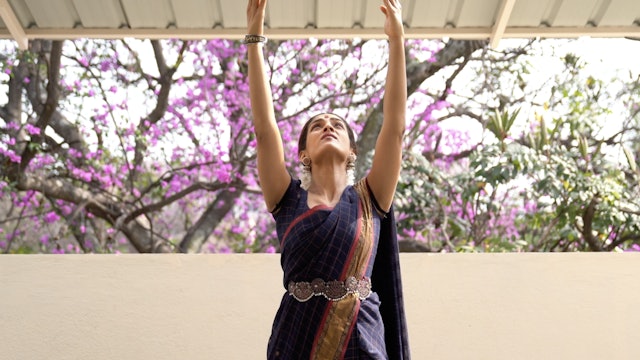-
Pādah bheda Shloka
The feet are considered one of the Angas, or major limbs according to the Natyashastra.
The movements of the feet are used not only for the precise control in the execution of Nritta but also to communicate meaning in the context of gesture.
Please refer to the Shloka below for pronunciation. P...
-
Ūru bheda Shloka
The thighs are considered one of the Upāngas, or minor limbs according to the Natyashastra.
The movements of the thighs are used not only for the precise control in the execution of Nritta but also to communicate meaning in the context of gesture.
Please refer to the Shloka below for pronunciat...
-
Janghā bheda Shloka
The shins/ shanks are considered one of the Upāngas, or minor limbs according to the Nātyaśāstra
The movements are used not only for the precise control in the execution of Nritta but also to communicate meaning in the context of gesture.
Please refer to the Shloka below for pronunciation. Plea...
-
Jānu bheda Shloka
Jānu bheda according to the Sangīta Ratnākara, is an Upānga. The knees are considered one of the minor limbs.
The movements of the knees are used not only for the precise control in the execution of Nritta but also to communicate meaning in the context of gesture. Some of the positions elucidate...
-
Gulphā bheda Shloka
The Ankle is considered one of the Upāngas, or minor limbs according to the Sangīta Ratnākara.
The movements of the ankle are important in pure dance and in emotive contexts.
Please refer to the Shloka below for pronunciation. Please note that the separate movements of the head when put togethe...
-
Pārśni bheda Shloka
The heels are considered one of the Upāngas, or minor limbs
The movements are used not only for the precise control in the execution of Nritta but also to communicate meaning in the context of gesture.
Please refer to the Shloka below for pronunciation. Please note that the separate movements ...
-
Thala bheda Shloka
The soles of the feet are considered one of the Upāngas, or minor limbs.
The movements are used not only for the precise control in the execution of Nritta but also to communicate meaning in the context of gesture.
Please refer to the Shloka below for pronunciation. Please note that the separat...
-
Bāhu bheda Shloka
The arms considered one of the Upāngas, or minor limbs.
The movements are used primarily to communicate meaning in the context of gesture and also clear articulation in dance or nritta.
Please refer to the Shloka below for pronunciation. Please note that the separate movements of the head when...
-
Udara bheda Shloka
The stomach is considered one of the Upāngas, or minor limbs.
The movements are used primarily to communicate meaning in the context of gesture.
Please refer to the Shloka below for pronunciation. Please note that the separate movements of the head when put together in a Shloka form 'Sandhis', ...
-
Mandi 1st speed
The Mandi Adavu gets it's name from the movement that involves the knee being placed on the ground alternately.
It is very important to do the exercises that strengthen the legs substantially and do all the exercises for Araimandi for a long period of time before embarking on this Adavu.
Boun...
-
Mandi Adavu Variations
The Mandi adavu is named such because there is a small jump on the balls of the feet after which the knee is placed on the ground.
Things to remember:
- stay lifted as much as possible without sitting on the heels
- keep pushing the thighs back and the heels forward to keep your muscles engaged... -
Jaar Adavu/ Sarikal Adavu 1
'Jaaru', literally means, to slide. This is also called the Sarikal Adavu. In the RK Method, we refer to the standing series that end in Samapada as the Jaar Adavu series and the other sliding Adavus that use Muzhumandi, and Aalidam as Sarikal adavus for simplicity.
This Adavu incorporates the s...
-
Jaar Adavu/ Sarikal Adavu 2
'Jaaru', literally means, to slide. This is also called the Sarikal Adavu. In the RK Method, we refer to the standing series that end in Samapada as the Jaar Adavu series and the other sliding Adavus that use Muzhumandi, and Aalidam as Sarikal adavus for simplicity.
This Adavu incorporates the ...
-
Jaar Adavu/ Sarikal Adavu 3
'Jaaru', literally means, to slide. This is also called the Sarikal Adavu. In the RK Method, we refer to the standing series that end in Samapada as the Jaar Adavu series and the other sliding Adavus that use Muzhumandi, and Aalidam as Sarikal adavus for simplicity.
This Adavu incorporates the s...
-
Vandeham Sharadam: Introduction
Vandeham Sharadam
Raga: Yamuna Kalyani
Mishra Chapu
Composer: Swami Dayananda Saraswati
Choreography: Rukmini Vijayakumar
Language: SanskritIt describes Goddess Saraswati, the embodiment of knowledge, speaking of how the knowledge of the self is revealed to those who have clarity of thought, ...
-
Vandeham Sharadam: Part 1
Vandeham Sharadam
Raga: Yamuna Kalyani
Mishra Chapu
Composer: Swami Dayananda Saraswati
Choreography: Rukmini Vijayakumar
Language: SanskritIt describes Goddess Saraswati, the embodiment of knowledge, speaking of how the knowledge of the self is revealed to those who have clarity of thought, ...

















